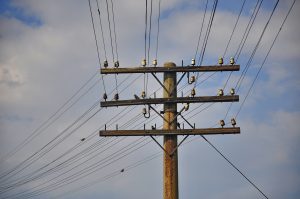Did you know investor owned electric utilities (IOUs) including Eversource, National Grid, Unitil, and Liberty Utilities don’t make money on the generation of electricity? I know that sounds strange, but it’s generally true.
In the late 1990s and early 2000s, utilities in New England produced or generated electricity, and delivered it to homes and businesses. The more electricity they sold, the more profits they made, so they had no incentive to drive down consumer use of electricity, which of course was bad for energy conservation.
Since then, many states “decoupled” electricity generation and electricity delivery. The big utilities were forced to sell off their centrally located electricity generation facilities (think power plants). The goal of this “deregulation” was to create competition among electricity generators which would drive down the cost of electricity to consumers.
One example of “decoupling” is the Pilgrim Nuclear Power Station in Plymouth, Massachusetts, a 690-megawatt General Electric-designed boiling water reactor. In 1999, Boston Edison (now Eversource), which owned and operated Pilgrim for years, sold the plant to Entergy Corp.
In today’s utility business model, which is overseen by state regulators, delivery companies “pass through” the cost of generating the electricity to customers without any markup. Thus, if Entergy sells Eversource $100 worth of electricity and Eversource delivers $100 worth of electricity to you, you pay $100. Eversource collects $100 from you but then sends it on to Entergy. (Yes, this is overly simplified but basically how it works.)
So if Eversource doesn’t make any money on the electricity itself, how does it make money to stay in business? Glad you asked.
As it turns out, investor-owned utilities are allowed to earn a profit on the distribution infrastructure they build. That is, they get a Return On Equity invested (ROE), typically around 9-10%.
 If a utility builds power lines and other infrastructure, they get to install the equipment, charge ratepayers for it, and tack a bit of profit onto the construction. Unfortunately, and not unlike the original utility model described at the beginning of this post, this approach to compensating utilities can drive them to do things that are in their best interest but not necessarily in the best interest of ratepayers or the environment. So any time a utility claims it “needs” to build a big capital project, be suspicious.
If a utility builds power lines and other infrastructure, they get to install the equipment, charge ratepayers for it, and tack a bit of profit onto the construction. Unfortunately, and not unlike the original utility model described at the beginning of this post, this approach to compensating utilities can drive them to do things that are in their best interest but not necessarily in the best interest of ratepayers or the environment. So any time a utility claims it “needs” to build a big capital project, be suspicious.
If you’ve made it this far, you might be wondering what all this has to do with solar electric systems. It matters because it explains why most investor-owned utilities resist distributed solar and, in fact, fight tooth and nail to deter solar growth.
So, back to the massive, centrally located electricity generation facilities I mentioned before. Unlike those, solar electricity generation systems are smaller and spread out, and usually located right where the electricity is needed, like your home. That’s why solar is considered a form of “distributed generation” i.e. generation that is distributed around a geographic area as opposed to centrally located.
Because solar is built right where the electricity is used, or at least closer to those areas, it means less distribution infrastructure is needed. But if utilities, who profit from building distribution facilities, can’t build as much, they can’t make as much money. And that makes their investors unhappy. It’s not really surprising that companies that profit from building electricity distribution infrastructure are less than solar-friendly.
It all makes perfect sense when you follow the tip made famous by the Watergate movie All the Presidents Men – “Follow the money.”
Here are two excellent articles with more information on this topic:
If you liked this article, you might also enjoy:
- The Solar Revolution is Over
- Can My Solar “Green Income” Be Taken Away?
- New Tariff Won’t Stop the Solar Trend







3 Responses to “How Electric Utilities Make Money”
Thank you Mark. I am in Massachusetts. What is the legislative solution that citizens should be lobbying for in order to reverse these un-solar-friendly incentives? Is there a link?
Thanks for reading, Ralph. Your timing is excellent. The MA Senate just passed a comprehensive energy bill that will address some of the utility roadblocks and encourage more solar. Citizens need to contact their Representative ASAP to voice their support for the provisions of that bill. I blogged about this yesterday: https://newenglandcleanenergy.com/energymiser/2018/06/20/steer-massachusetts-in-the-right-clean-energy-direction/ Longer-term, the entire utility business model needs to be re-designed. But for now, just allowing distributed generation like solar to be built is a great start.
Thank you Mark. Posted your state legislatture action link to Cambridge Town Hall Facebook, recommend you post to Facebooks like WGBH, MassPIRG, other Massachusetts activists FBs. I also posted to Clamshell Alliance FB, you get the idea! https://www.facebook.com/groups/cambridgetownhall/permalink/182501205760054/
The comments are closed.